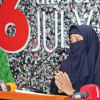In celebration of our newfound freedom, everyone is expressing themselves in different ways, one of which is through murals and graffiti. Walk through the campus of Dhaka University and you will see how the walls of DU have been revitalised into vibrant canvases that convey messages of understanding, harmony, and freedom of expression. Behind this transformation are the bright minds and skilled hands of students, who we hope, will propel the country forward.
Indeed, not only DU and its adjacent areas, but overall, the streets of Dhaka are being transformed in meaningful ways. Reflecting on this transformation, Morshed Mishu, a celebrated cartoonist and the Assistant Editor of Unmad, who has been pursuing activism through art for years and inspired many to take up paintbrushes to express their demands, notes, "Graffiti and murals convey impactful messages. For starters, they keep reminding everyone about the spirit of our protest and can be used to educate the public about important topics such as communal harmony and the value of tolerance."

He adds, "Our struggle for freedom began a long time ago," recalling the movement of 2018 when students presented their demands despite the pervasive fear. "People were afraid back then but they continued to paint and write. Now in 2024, that fear has dissipated. We have learned to harness our voices and fight for our freedom."
These artistic expressions also play an educational role, teaching observers about the history and ongoing efforts in the fight for social justice. Graffiti and murals encourage viewers to reflect on their positions within these narratives and consider their roles in the broader societal framework.

"Young people are giving new life to old, neglected walls through paintings and we all should appreciate their efforts," Mishu elaborates. He encourages young artists to be intentional in their efforts, "They should paint not only to beautify but to inspire and enlighten."
This advice highlights the dual purpose of such art – it beautifies while it educates and it delights while it informs.
The strategic placement of these murals and graffiti can turn every wall into a message board, reminding viewers of the ongoing struggles and victories in the fight for civil liberties. Moreover, the influence of such art extends beyond the confines of walls. Social media platforms have become conduits for these messages to travel worldwide, amplifying their impact.
That said, not all expressions on these walls are welcomed and we have also witnessed a surge in abrasive graffiti and murals. "There were coarse graffiti painted during the recent protests, which should be erased. But the murals and graffiti that voice our demands should be preserved, as these graffitis represents the history of July Movement." Mishu believes.

This distinction highlights the importance of intention behind the artwork emphasising that while some spontaneous expressions may reflect momentary emotions, those that resonate with the collective aspirations should endure.
The historical roots of murals and graffiti as tools of societal dialogue and protest stretch back hundreds of years. From the political frescoes of the 1952 Language Movement to the "Subodh series" featuring the slogan, "Subodh tui paliye jaa, tor bhagge kichu nei," which became popular in 2016 – these artworks symbolise the ongoing struggle for justice and the need for continual renewal of commitment to societal issues.

Just as murals may fade or be painted over, the issues they represent require persistent engagement and advocacy. Hence, as we look forward, we must recognise murals and graffiti not just as art forms but as educational tools that can foster a more engaged and informed citizenry. Because art, with its premeditated messages, can transform passive observers into active participants in the democratic process.








Comments